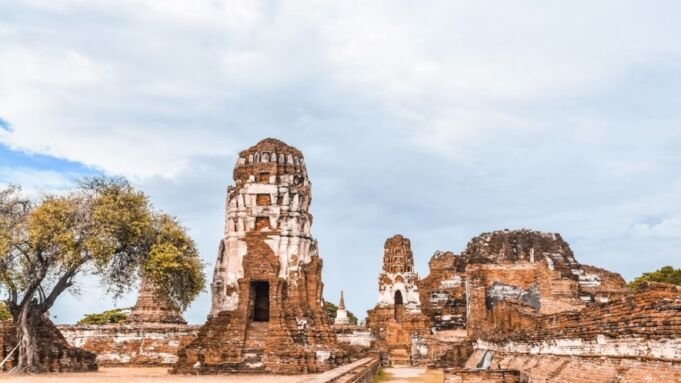Spirituality and spectacle. Solitude and selfies. Enlightenment and souvenir shops. People voyaging to the world’s holiest sites will always encounter conflicting scenarios. Crowded chaos locked in with peace and bliss.
It is, however, not the magical sites themselves that hold the ingredient for a soul-stirring journey through hallowed lands. Instead, the spark resides within each of us, in the ways we embrace the experiences in the landscape, structures, artifacts, and doctrine.
In between the hustling and bustling of swarming crowds, you may find moments of quiet connections: sensing the light of the Golden Temple at daybreak; hearing sounds of Gregorian melody that echo Notre Dame’s wooden interior at nightfall; a glimpse of saffron monks from afar sending lotuses to float behind currents on Ganges!
The worldwide industry for spiritual travel amounted to an estimated value of 1.3 billion dollars last year. Researchers predict solid continued growth over the upcoming years, with projections that revenue in this tourism niche could reach 1.9 billion dollars by 2028.
This guide shares tips and ideas for stepping off packed tourist routes to uncover deeper meaning at 5 of the world’s most popular sacred tourist destinations.
Featured Sacred Sites: How Can You Make the Most of Them
The world is replete with sacrosanct sites that have drawn spiritual seekers and curious travelers for millennia. But, modern commercialization threatens to diminish the awe these holy places inspire. By traveling with purpose and an open mindset, you can connect to the essence of these sites and enrich your soul.
Vatican City & St. Peter’s Basilica
If you wish to beat the gushing crowd at St. Peter’s Square, come in an hour early, before the gates open to the public. Treat yourself to the magnificent fountain waters surrounding the buildings in the desolate streets of the Square.
You can stay till sunset and marvel at Michelangelo’s dome bathing in the sun’s soft pink light. Local guides will be more than happy to give you a special tour of the giant church. If time permits, you can also visit saint relics and papal tombs.
If you are an adventure seeker, you will not be disappointed here. Climb the dome and soak in the splendid city views. As discussed earlier, you need to dress appropriately. Be careful not to show your bare shoulders or legs.
Before bidding adieu to this wonderful site, do not forget to take a peaceful stroll through the pleasant-smelling garden’s fences, quiet fountains, and exotic palms.
Jerusalem’s Old City & Holy Land
As a vibrant and alluring metropolis, Jerusalem holds deep spiritual meaning for followers of Judaism, Islam, and Christianity. These three faiths collectively encompass over a third of people worldwide today.
According to Isrotel, its legacy as a hub of religious heritage and enduring sacred sites makes this remarkable city extraordinarily revered on the global stage.
The incense-scented alleys will walk you through the city’s 4,000-year-old history. Every once in a while, stop on your journey to be amazed by the well-kept secrets of the city.
The Western Wall and Church of the Holy Sepulchre light up beautifully at dawn or dusk, with the glowing light and shadows falling on them. Bring modest wear covering knees and shoulders since some sites request this.
You can also plan to hike the Mount of Olives and enjoy the stunning panorama of Temple Mount.
After hours of walking and traveling, you can savor relaxed evenings in the best 2 hotels in Jerusalem. Enjoy the saunas and the Turkish baths while reflecting on the divinity and the peace of your travels.
Varanasi & the Ganges
Varanasi, one of the oldest inhabited cities, comes alive at dawn. With the banks covered in smoldering funeral pyres, you can see pilgrims standing on the East-facing bank steps immersed in their morning rituals.
A boat ride offers a timeless view of temples basking in golden light. At dusk, witness a mystical ceremony with thousands of devotees standing by the river Ganga, holding illuminated candles and chanting Vedic hymns.
If you love trying out different varieties of food, Varanasi is heaven for you. The city is famous all over the world for its roadside snacks, locally known as ‘chaat.’
The city’s aura lies in the temple bells and monk chants, celebrating the city’s spirit. When you seek solace, find a perch on weathered stairs leading to the Ganges. Behold the profound cycle of life and rebirth as pilgrims ritually immerse in the healing waters, symbolizing the intertwining of the physical and spiritual in India’s sacred soul.
Buddhist Temples in Tibet
Referred to as the “Roof of the World,” Tibet’s landscape is a surreal amalgamation of rugged terrains and snow-capped mountains. It is also known for its Buddhist temples that stand as the epitome of architecture and faith.
If there is one thing that you will love about their temples, it is the huge copper wheels and the constant chants of “Om Mani Padme Hum” filling the air. You can choose to walk amid saffron and crimson robes and lose yourself in the activities of the community.
You can also choose to sit with the monks and sip butter tea before the golden statues of Buddha.
At dawn, step out from temple dorms and surround yourself with pilgrims holding beads and murmuring in a mesmerizing chorus. These temples witness the devotion that spans centuries and persists among the Himalayan peaks.
Guided by the mind, body, and dharma, each step here follows the awakening path.
Challenges of Spiritual Tourism
We live in the modern era of social media. Here, the smallest of things, like a food stall, can become the world’s center of attraction within a few hours. It is welcome in some cases, but sometimes, it is best to leave the idea or the place away from the gleeful stare of the world.
Sadly, unwarranted exposure is being meted out to many holy sites around the world. The ethos and the sanctity of such places are getting stiff competition from modern tourism’s less enlightened byproducts.
The huge influx of fellow visitors often overwhelms the place’s ambiance. Praying pilgrims may find their concentration fading away from the throngs of selfie snappers invading the plaza at the Western Wall in Jerusalem.
Tourists flock in tens of thousands each day at the Emerald Buddha Temple in Thailand; with their chatters drowning monks’ chants! Even secluded monasteries like Mt. Athos in Greece and Machu Picchu in Peru, have complained of noise and pollution from increasing visitor influxes.
Cross-cultural communication challenges can also compound spiritual tourism difficulties. Visitors often can’t connect to native perspectives providing in-depth context for holy sites. Many racing to tick sights off their checklists rarely grasp cultural and theological nuances.
Then there’s the issue of encroaching businesses aiming to capitalize on the holy sites’ appeal. You can see a plethora of fast food stalls lining the pathways toward temples in India. Sadly, the same can be said about the pilgrimage site in Lourdes, France.
How can you rise above such pressing concerns to embark on an enlightening spiritual voyage instead of an irritating tour? The answer lies in reconsidering pilgrimage as an inner journey rather than a pre-packaged site.
Quiet your devices, awaken your senses, and strive to view holy grounds not as profitable photo ops but as gateways for soulful bonds. Be one with the surroundings, imbibing the essence of its existence. Do not try to leave your mark.
Cultivating Meaningful Spiritual Experiences as a Tourist
You need to prepare before you set out for your profound, holy journey. Study customs, protocols, and origins and plan your journey accordingly. If you plan on visiting a site during a local tradition, be a part of it and not a bystander clicking pictures.
Be present. Whenever you can, chat with the locals, guides, and fellow travelers to understand the nuanced details guarded by centuries-old structures. Be mindful of your habits and never pollute your surroundings.
Many places of worship have dress codes. If you wish to explore these sites and the dressing norms do not resonate with you, take a step back. Your reaction would be solely based on your views. Try to empathize with the local customs and beliefs.
To conclude, stay with local families if possible. This will help you imbibe their flavor to the fullest. Moreover, your stay might be a big financial help to the family. Have an open and curious mindset – let go of expectations. Embrace the moments as they are and soak in the fervor.















